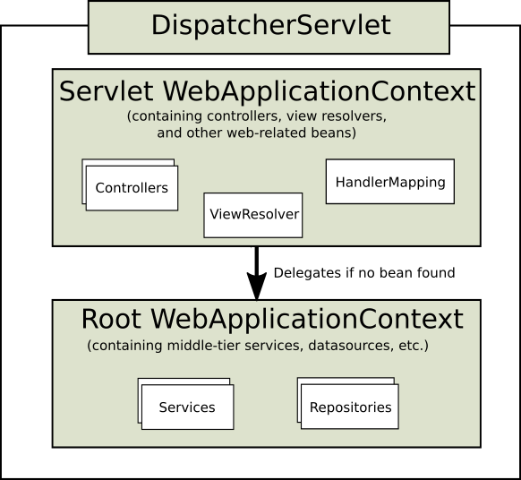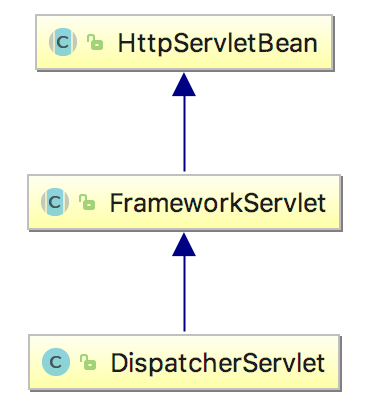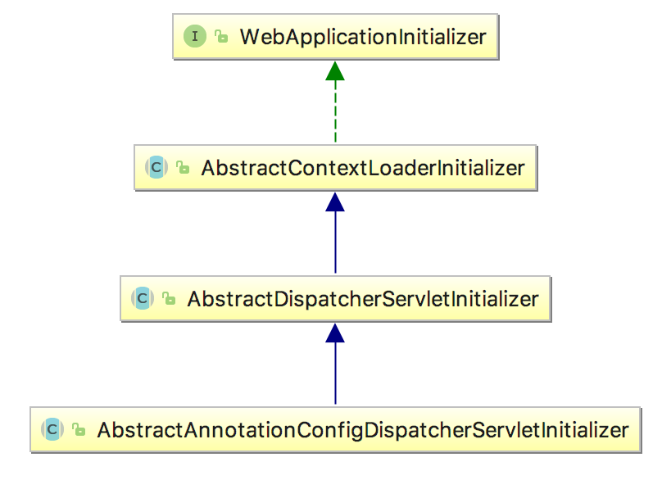转载于http://www.tianshouzhi.com/api/tutorials/spring
1.0 spring与springmvc父子容器
1、spring和springmvc父子容器概念介绍
在spring和springmvc进行整合的时候,一般情况下我们会使用不同的配置文件来配置spring和springmvc,因此我们的应用中会存在至少2个ApplicationContext实例,由于是在web应用中,因此最终实例化的是ApplicationContext的子接口WebApplicationContext(一个用来放controller、viewResolver、handlerMapping;
另个一用来放service、mapper等)。如下图所示:

上图中显示了2个WebApplicationContext实例,为了进行区分,分别称之为:Servlet WebApplicationContext、Root WebApplicationContext。 其中:
Servlet WebApplicationContext:这是对J2EE三层架构中的web层进行配置,如控制器(controller)、视图解析器(view resolvers)等相关的bean。
通过spring mvc中提供的DispatchServlet来加载配置,通常情况下,配置文件的名称为spring-servlet.xml。
Root WebApplicationContext:这是对J2EE三层架构中的service层、dao层进行配置,如业务bean,数据源(DataSource)等。通常情况下,配置文件的名称为applicationContext.xml。在web应用中,其一般通过ContextLoaderListener来加载。
以下是一个web.xml配置案例:
<?xml version="1.0" encoding="UTF-8"?>
<web-app version="3.0" xmlns="http://java.sun.com/xml/ns/javaee"
xmlns:xsi="http://www.w3.org/2001/XMLSchema-instance"
xsi:schemaLocation="http://java.sun.com/xml/ns/javaeehttp://java.sun.com/xml/ns/javaee/web-app_3_0.xsd">
<!—创建Root WebApplicationContext-->
<context-param>
<param-name>contextConfigLocation</param-name>
<param-value>/WEB-INF/spring/applicationContext.xml</param-value>
</context-param>
<listener>
<listener-class>org.springframework.web.context.ContextLoaderListener</listener-class>
</listener>
<!—创建Servlet WebApplicationContext-->
<servlet>
<servlet-name>dispatcher</servlet-name>
<servlet-class>org.springframework.web.servlet.DispatcherServlet</servlet-class>
<init-param>
<param-name>contextConfigLocation</param-name>
<param-value>/WEB-INF/spring/spring-servlet.xml</param-value>
</init-param>
<load-on-startup>1</load-on-startup>
</servlet>
<servlet-mapping>
<servlet-name>dispatcher</servlet-name>
<url-pattern>/*</url-pattern>
</servlet-mapping>
</web-app>
在上面的配置中:
1、 ContextLoaderListener会被优先初始化时,其会根据<context-param>元素中contextConfigLocation参数指定的配置文件路径,在这里就是"/WEB-INF/spring/applicationContext.xml”,来创建WebApplicationContext实例。 并调用ServletContext的setAttribute方法,将其设置到ServletContext中,属性的key为”org.springframework.web.context.WebApplicationContext.ROOT”,最后的”ROOT"字样表明这是一个 Root WebApplicationContext。
2、DispatcherServlet在初始化时,会根据<init-param>元素中contextConfigLocation参数指定的配置文件路径,即"/WEB-INF/spring/spring-servlet.xml”,来创建Servlet WebApplicationContext。同时,其会调用ServletContext的getAttribute方法来判断是否存在Root WebApplicationContext。如果存在,则将其设置为自己的parent。这就是父子上下文(父子容器)的概念。
父子容器的作用在于,当我们尝试从child context(即:Servlet WebApplicationContext)中获取一个bean时,如果找不到,则会委派给parent context (即Root WebApplicationContext)来查找。
如果我们没有通过ContextLoaderListener来创建Root WebApplicationContext,那么Servlet WebApplicationContext的parent就是null,也就是没有parent context。
2、为什么要有父子容器
笔者理解,父子容器的作用主要是划分框架边界。
在J2EE三层架构中,在service层我们一般使用spring框架, 而在web层则有多种选择,如spring mvc、struts等。因此,通常对于web层我们会使用单独的配置文件。例如在上面的案例中,一开始我们使用spring-servlet.xml来配置web层,使用applicationContext.xml来配置service、dao层。如果现在我们想把web层从spring mvc替换成struts,那么只需要将spring-servlet.xml替换成Struts的配置文件struts.xml即可,而applicationContext.xml不需要改变。
事实上,如果你的项目确定了只使用spring和spring mvc的话,你甚至可以将service 、dao、web层的bean都放到spring-servlet.xml中进行配置,并不是一定要将service、dao层的配置单独放到applicationContext.xml中,然后使用ContextLoaderListener来加载。在这种情况下,就没有了Root WebApplicationContext,只有Servlet WebApplicationContext。
自己的思考:
1、通常我们在依赖的时候都是controller中会注入service或者dao等,所以一般而言,service、dao需要优先加载,这样后面子容器在初始化的时候直接注入就行了,不需要dependson父容器了;这也有可能是其中一个原因;
2、父子容器,肯定得先初始化父容器,再初始化子容器;不然子容器在初始化的时候就无法指定父容器,后续在取bean的时候(先在子容器取,取不到再到父容器中取)就会有问题,找不到父容器了;
父子上下文容器结构。
Tomcat启动时,监听器ContextLoaderListener创建一个XMLWebApplicationContext上下文容器,并加载context-param中的配置文件,完成容器的刷新后将上下文设置到ServletContext。
当DispatcherServlet创建时,先进行初始化操作,从ServletContext中查询出监听器中创建的上下文对象,作为父类上下文来创建servlet的上下文容器,并加载Servlet配置中的init-param的配置文件(默认加载/WEB-INF/servletName-servlet.xml,servletName为DispatcherServlet配置的servlet-name),然后完成容器的刷新。子上下文可以访问父上下文中的bean,反之则不行。
3、Root WebApplicationContext创建过程源码分析
ContextLoaderListener用于创建ROOT WebApplicationContext,其实现了ServletContextListener接口的contextInitialized和contextDestroyed方法,在web应用启动和停止时,web容器(如tomcat)会负责回调这两个方法。而创建Root WebApplicationContext就是在contextInitialized中完成的,相关源码片段如下所示:
org.springframework.web.context.ContextLoaderListener
public class ContextLoaderListener extends ContextLoader implements ServletContextListener {
//...
@Override
public void contextInitialized(ServletContextEvent event) {
initWebApplicationContext(event.getServletContext());
}
//...
}
可以看到ContextLoaderListener继承了ContextLoader类,真正的创建在操作,是在ContextLoader的initWebApplicationContext方法中完成。
org.springframework.web.context.ContextLoader#initWebApplicationContext
public WebApplicationContext initWebApplicationContext(ServletContext servletContext) {
//1、保证只能有一个ROOT WebApplicationContext
//尝试以”org.springframework.web.context.WebApplicationContext.ROOT”为key从ServletContext中查找WebApplicationContext实例
//如果已经存在,则抛出异常。
//一个典型的异常场景是在web.xml中配置了多个ContextLoaderListener,那么后初始化的ContextLoaderListener就会抛出异常
if (servletContext.getAttribute(WebApplicationContext.ROOT_WEB_APPLICATION_CONTEXT_ATTRIBUTE) != null) {
throw new IllegalStateException(
"Cannot initialize context because there is already a root application context present - " +
"check whether you have multiple ContextLoader* definitions in your web.xml!");
}
//2、打印日志,注意日志中的提示内容:"Initializing Spring root WebApplicationContext”
//这验证了我们之前的说法,ContextLoaderListener创建的是root WebApplicationContext
Log logger = LogFactory.getLog(ContextLoader.class);
servletContext.log("Initializing Spring root WebApplicationContext");
if (logger.isInfoEnabled()) {
logger.info("Root WebApplicationContext: initialization started");
}
long startTime = System.currentTimeMillis();
try {
if (this.context == null) {
// 3 创建WebApplicationContext实现类实例。其内部首先会确定WebApplicationContext实例类型。
// 首先判断有没有<context-param>元素的<param-name>值为contextClass,如果有,则对应的<param-value>值,
// 就是要创建的WebApplicationContext实例类型;
// 如果没有指定,则默认的实现类为XmlWebApplicationContext。这是在spring-web-xxx.jar包中的ContextLoader.properties指定的
// 注意这个时候,只是创建了WebApplicationContext对象实例,还没有加载对应的spring配置文件
this.context = createWebApplicationContext(servletContext);
}
//4 XmlWebApplicationContext实现了ConfigurableWebApplicationContext接口,因此会进入if代码块
if (this.context instanceof ConfigurableWebApplicationContext) {
ConfigurableWebApplicationContext cwac = (ConfigurableWebApplicationContext) this.context;
// 4.1 由于WebApplicationContext对象实例还没有加载对应配置文件,spring上下文还没有被刷新,因此isActive返回false,进入if代码块
if (!cwac.isActive()) {
//4.2 当前ROOT WebApplicationContext的父context为null,则尝试通过loadParentContext方法获取父ApplicationContext,并设置到其中
//由于loadParentContext方法目前写死返回null,因此可以忽略4.2这个步骤。
if (cwac.getParent() == null) {
ApplicationContext parent = loadParentContext(servletContext);
cwac.setParent(parent);
}
//4.3 加载配置spring文件。根据<context-param>指定的contextConfigLocation,确定配置文件的位置。
configureAndRefreshWebApplicationContext(cwac, servletContext);
}
}
// 5、将创建的WebApplicationContext实例以”org.springframework.web.context.WebApplicationContext.ROOT”为key设置到ServletContext中
servletContext.setAttribute(WebApplicationContext.ROOT_WEB_APPLICATION_CONTEXT_ATTRIBUTE, this.context);
ClassLoader ccl = Thread.currentThread().getContextClassLoader();
if (ccl == ContextLoader.class.getClassLoader()) {
currentContext = this.context;
}
else if (ccl != null) {
currentContextPerThread.put(ccl, this.context);
}
if (logger.isDebugEnabled()) {
logger.debug("Published root WebApplicationContext as ServletContext attribute with name [" +
WebApplicationContext.ROOT_WEB_APPLICATION_CONTEXT_ATTRIBUTE + "]");
}
if (logger.isInfoEnabled()) {
long elapsedTime = System.currentTimeMillis() - startTime;
logger.info("Root WebApplicationContext: initialization completed in " + elapsedTime + " ms");
}
return this.context;
}
catch (RuntimeException ex) {
logger.error("Context initialization failed", ex);
servletContext.setAttribute(WebApplicationContext.ROOT_WEB_APPLICATION_CONTEXT_ATTRIBUTE, ex);
throw ex;
}
catch (Error err) {
logger.error("Context initialization failed", err);
servletContext.setAttribute(WebApplicationContext.ROOT_WEB_APPLICATION_CONTEXT_ATTRIBUTE, err);
throw err;
}
}
protected WebApplicationContext createWebApplicationContext(ServletContext sc) {
// 根据加载的配置文件ContextLoad.properties的配置属性,去决定用哪个实现实例化Root ApplicationContext
// XmlWebApplicationContext
Class<?> contextClass = this.determineContextClass(sc);
if (!ConfigurableWebApplicationContext.class.isAssignableFrom(contextClass)) { throw new ApplicationContextException("Custom context class [" + contextClass.getName() + "] is not of type [" + ConfigurableWebApplicationContext.class.getName() + "]"); } else { return (ConfigurableWebApplicationContext)BeanUtils.instantiateClass(contextClass); } }
protected Class<?> determineContextClass(ServletContext servletContext) {
// applicationContext.xml中是否有配置属性contextClass,如果有的话直接初始化该对象 String contextClassName = servletContext.getInitParameter("contextClass"); if (contextClassName != null) { try { return ClassUtils.forName(contextClassName, ClassUtils.getDefaultClassLoader()); } catch (ClassNotFoundException var4) { throw new ApplicationContextException("Failed to load custom context class [" + contextClassName + "]", var4); } } else {
// 如果没有的话直接调用spring的默认实现Context-XmlWebApplicationContext contextClassName = defaultStrategies.getProperty(WebApplicationContext.class.getName()); try { return ClassUtils.forName(contextClassName, ContextLoader.class.getClassLoader()); } catch (ClassNotFoundException var5) { throw new ApplicationContextException("Failed to load default context class [" + contextClassName + "]", var5); } } }
// 类在加载的时候直接把属性加载到属性defaultStrategies 中去
.....
private static final Properties defaultStrategies;
static { try { ClassPathResource resource = new ClassPathResource("ContextLoader.properties", ContextLoader.class); defaultStrategies = PropertiesLoaderUtils.loadProperties(resource); } catch (IOException var1) { throw new IllegalStateException("Could not load 'ContextLoader.properties': " + var1.getMessage()); } currentContextPerThread = new ConcurrentHashMap(1); }
BeanUtils.instantiateClass(contextClass);
public static <T> T instantiateClass(Class<T> clazz) throws BeanInstantiationException { Assert.notNull(clazz, "Class must not be null"); if (clazz.isInterface()) { throw new BeanInstantiationException(clazz, "Specified class is an interface"); } else { try { return instantiateClass(clazz.getDeclaredConstructor()); } catch (NoSuchMethodException var2) { throw new BeanInstantiationException(clazz, "No default constructor found", var2); } } }
XmlWebApplicationContext
public static <T> T instantiateClass(Constructor<T> ctor, Object... args) throws BeanInstantiationException { Assert.notNull(ctor, "Constructor must not be null"); try { ReflectionUtils.makeAccessible(ctor); return ctor.newInstance(args); } catch (InstantiationException var3) { throw new BeanInstantiationException(ctor.getDeclaringClass(), "Is it an abstract class?", var3); } catch (IllegalAccessException var4) { throw new BeanInstantiationException(ctor.getDeclaringClass(), "Is the constructor accessible?", var4); } catch (IllegalArgumentException var5) { throw new BeanInstantiationException(ctor.getDeclaringClass(), "Illegal arguments for constructor", var5); } catch (InvocationTargetException var6) { throw new BeanInstantiationException(ctor.getDeclaringClass(), "Constructor threw exception", var6.getTargetException()); } }
ContextLoad.properties
# Default WebApplicationContext implementation class for ContextLoader.
# Used as fallback when no explicit context implementation has been specified as context-param.
# Not meant to be customized by application developers.
org.springframework.web.context.WebApplicationContext=org.springframework.web.context.support.XmlWebApplicationContext
通过定位到某个类,查看这个类的UML结构,这样的话整个结构就能一目了然

4、Servlet WebApplicationContext创建过程源码分析
DispatcherServlet负责创建Servlet WebApplicationContext,并尝试将ContextLoaderListener创建的ROOT WebApplicationContext设置为自己的parent。其类图继承关系如下所示:

dispatcherServlet->frameworkServlet->httpservletBean->HttpServlet
其中HttpServletBean继承了HttpServlet,因此在应用初始化时,其init方法会被调用,如下:
org.springframework.web.servlet.HttpServletBean#init
public final void init() throws ServletException {
//...
// 这个方法在HttpServletBean中是空实现
initServletBean();
if (logger.isDebugEnabled()) {
logger.debug("Servlet '" + getServletName() + "' configured successfully");
}
}
HttpServletBean的init方法中,调用了initServletBean()方法,在HttpServletBean中,这个方法是空实现。FrameworkServlet覆盖了HttpServletBean中的initServletBean方法,如下:
org.springframework.web.servlet.FrameworkServlet#initServletBean
@Override
protected final void initServletBean() throws ServletException {
getServletContext().log("Initializing Spring FrameworkServlet '" + getServletName() + "'");
if (this.logger.isInfoEnabled()) {
this.logger.info("FrameworkServlet '" + getServletName() + "': initialization started");
}
long startTime = System.currentTimeMillis();
try {
// initWebApplicationContext方法中,创建了Servlet WebApplicationContext实例
this.webApplicationContext = initWebApplicationContext();
initFrameworkServlet();
}
catch (ServletException ex) {
this.logger.error("Context initialization failed", ex);
throw ex;
}
catch (RuntimeException ex) {
this.logger.error("Context initialization failed", ex);
throw ex;
}
if (this.logger.isInfoEnabled()) {
long elapsedTime = System.currentTimeMillis() - startTime;
this.logger.info("FrameworkServlet '" + getServletName() + "': initialization completed in " +
elapsedTime + " ms");
}
}
上述代码片段中,我们可以看到通过调用FrameworkServlet的另一个方法initWebApplicationContext(),来真正创建WebApplicationContext实例,其源码如下:
org.springframework.web.servlet.FrameworkServlet#initWebApplicationContext
protected WebApplicationContext initWebApplicationContext() {
//1 通过工具类WebApplicationContextUtils来获取Root WebApplicationContext
// 其内部以”org.springframework.web.context.WebApplicationContext.ROOT”为
// key从ServletContext中查找WebApplicationContext实例作为rootContext
WebApplicationContext rootContext = WebApplicationContextUtils.getWebApplicationContext(getServletContext());
WebApplicationContext wac = null;
//2、在我们的案例中是通过web.xml配置的DispatcherServlet,此时webApplicationContext为null,因此不会进入以下代码块
if (this.webApplicationContext != null) {
// A context instance was injected at construction time -> use it
wac = this.webApplicationContext;
if (wac instanceof ConfigurableWebApplicationContext) {
ConfigurableWebApplicationContext cwac = (ConfigurableWebApplicationContext) wac;
if (!cwac.isActive()) {
// The context has not yet been refreshed -> provide services such as
// setting the parent context, setting the application context id, etc
if (cwac.getParent() == null) {
// The context instance was injected without an explicit parent -> set
// the root application context (if any; may be null) as the parent
cwac.setParent(rootContext);
}
configureAndRefreshWebApplicationContext(cwac);
}
}
}
//3 经过第二步,wac依然为null,此时尝试根据FrameServlet的contextAttribute 字段的值,
从ServletContext中获取Servlet WebApplicationContext实例,在我们的案例中,contextAttribute值为空,因此这一步过后,wac依然为null
if (wac == null) {
// No context instance was injected at construction time -> see if one
// has been registered in the servlet context. If one exists, it is assumed
// that the parent context (if any) has already been set and that the
// user has performed any initialization such as setting the context id
wac = findWebApplicationContext();
}
//4 开始真正的创建Servlet WebApplicationContext,并将rootContext设置为parent
if (wac == null) {
// No context instance is defined for this servlet -> create a local one
wac = createWebApplicationContext(rootContext);
}
if (!this.refreshEventReceived) {
// Either the context is not a ConfigurableApplicationContext with refresh
// support or the context injected at construction time had already been
// refreshed -> trigger initial onRefresh manually here.
// 开始初始化springMvc组件
onRefresh(wac);
}
if (this.publishContext) {
// Publish the context as a servlet context attribute.
String attrName = getServletContextAttributeName();
getServletContext().setAttribute(attrName, wac);
if (this.logger.isDebugEnabled()) {
this.logger.debug("Published WebApplicationContext of servlet '" + getServletName() +
"' as ServletContext attribute with name [" + attrName + "]");
}
}
return wac;
}
protected WebApplicationContext findWebApplicationContext() { String attrName = this.getContextAttribute(); if (attrName == null) { return null; } else { WebApplicationContext wac = WebApplicationContextUtils.getWebApplicationContext(this.getServletContext(), attrName); if (wac == null) { throw new IllegalStateException("No WebApplicationContext found: initializer not registered?"); } else { return wac; } } }
5 java方式配置
最后,对于Root WebApplicationContext和Servlet WebApplicationContext的创建,我们也可以通过java代码的方式进行配置。spring通过以下几个类对此提供了支持:
AbstractContextLoaderInitializer:其用于动态的往ServletContext中注册一个ContextLoaderListener,从而创建Root WebApplicationContext
AbstractDispatcherServletInitializer:其用于动态的往ServletContext中注册一个DispatcherServlet,从而创建Servlet webApplicationContext
对应的类图继承关系如下所示:

AbstractAnnotationConfigDispatcherServletInitializer用于提供AbstractContextLoaderInitializer和AbstractDispatcherServletInitializer所需要的配置。
AbstractAnnotationConfigDispatcherServletInitializer中有3个抽象方法需要实现:
public class MyWebAppInitializer extends AbstractAnnotationConfigDispatcherServletInitializer {
//获得创建Root WebApplicationContext所需的配置类
@Override
protected Class<?>[] getRootConfigClasses() {
return new Class<?[] { RootConfig.class };
}
//获得创建Servlet WebApplicationContext所需的配置类
@Override
protected Class<?>[] getServletConfigClasses() {
return new Class<?[] { App1Config.class };
}
//获得DispatchServlet拦截的url
@Override
protected String[] getServletMappings() {
return new String[] { "/app1/*" };
}
}